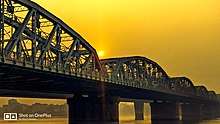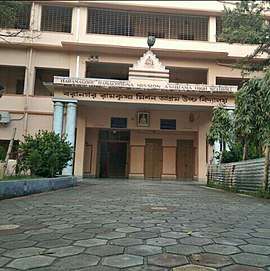Vivekananda Setu
Vivekananda Setu (also called Willingdon Bridge and Bally Bridge) is a bridge over the Hooghly River in West Bengal, India. It links the city of Howrah, at Bally, to its twin city of Kolkata, at Dakshineswar. Completed on 12 December 1930 & opened on 28 December 1930, it is a multispan steel bridge and was built to provide road and rail links between the Calcutta Port and its hinterland. It is 2,960 feet (900 m) long having 9 Spans in total. The famous Dakshineswar Temple is situated on the banks of the Hooghly River near the Bally Bridge. The bridge is one of 4 bridges & the 2nd Oldest Bridge linking Howrah and Kolkata.The Bridge is about 90 years old and still standing tall. Since 2007, it's been accompanied by a new bridge, Nivedita Setu, 50m downstream.
Vivekananda Setu | |
|---|---|
 Vivekananda Setu | |
| Coordinates | 22°39′11″N 88°21′12″E |
| Carries | Rail cum Road bridge |
| Crosses | Hooghly River |
| Locale | Bally-Dakshineswar |
| Characteristics | |
| Material | Steel and Stone |
| Total length | 2,960 feet (900 m) |
| History | |
| Opened | 1930 |

| |
Naming
The bridge was originally named Willingdon Bridge after Viceroy of India, Freeman Freeman-Thomas, 1st Marquess of Willingdon, who inaugurated it.[1] It was eventually renamed Bally Bridge, before officially becoming known as Vivekananda Setu.
Construction

The erection and Caissoning of the bridge was done by noted Kutchi-Mestri railway contractor and Industrialist Rai Bahadur Jagmal Raja.[1][2] His nameplate can still be seen on each girder of the bridge.[1] The construction of bridge started in year 1926 and was completed in year 1932.[2][1] The fabrication of the bridge was done at works of Braithwate & Company, Calcutta.[2][1]
The Bridge was built with eight spans laid at distance of 300 ft each. The length of bridge is almost half mile with 10 km approach roads on both sides.[1][3] The foundation laid with well-sinking 100 ft down the river beds, girding, erection of abutments, arching was all done by Jagmal Raja.[1] This Railway bridge is also important in annals of History of Railway in India because the Railway for the first time crossed over River Hooghly and reached Calcutta at Sealdah Terminus[1]
The first train that ran across the bridge was named Jagmal Raja Howrah Express by the British, acknowledging the feat of Rai Bahadur Jagmal Raja. The bridge cost over ₹1 crore (US$140,000) in those years.[1]
Usage

The bridge serves both road and rail:
- Rail - connects Sealdah Station to Delhi
- Road - connects Grand Trunk Road (Howrah side) to Barrackpore Trunk Road (Kolkata side)
This bridge has recently handled a daily traffic of 24,000 vehicles.[4]
Vivekananda Setu had become weak as a result of ageing, and with heavy traffic, even repairs became difficult. There was need for a second bridge. Nivedita Setu was constructed parallel to it and around 50 metres (165 ft) downstream.[5] It was opened to traffic in 2007. Vivekananda Setu allows traffic movement upstream (Bally to Kolkata) while Nivedita Setu helps downstream transport (from Kolkata to Bally).
See also
References
| Wikimedia Commons has media related to Vivekananda Setu. |
- Diary of Golden Days at Jharia – A Memoir & History of Gurjar Kashtriya Samaj of Kutch in Coalfields of Jharia – written by Natwarlal Devram Jethwa of Calcutta compiled by Raja Pawan Jethwa published in year 1998 in English. Life sketch of Rai Bahadur Jagmal Raja Chauhan pp:33.
- Minutes of proceedings of the Institution of Civil Engineers, London 1934 : Willingdon Bridge & Rai Bahadur Jagamal Raja, Volume 235, Part 1, page 83.
- Conditions and Prospects of United Kingdom Trade in India: (with a Brief Account of the Trade of Burma).Great Britain. Dept. of Overseas Trade ;H.M. Stationery Office, 1928 - India pp:136.
- "Famous Bridges of India – Vivekananda Setu". India Travel News. Retrieved 6 July 2011.
- "Famous Bridges of India – Nivedita Setu". India Travel News. Archived from the original on 24 September 2015. Retrieved 6 July 2011.

